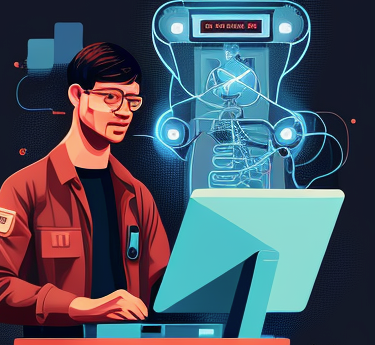 |
| The Future of AI |
Artificial Intelligence (AI) is no longer a concept confined to science fiction. As we step into 2025, AI has become an integral part of our daily lives, revolutionizing industries and reshaping society in ways we could only imagine a few years ago. Whether you're a student, professional, or retiree, understanding how artificial intelligence will impact your future is crucial. Let’s explore how AI is transforming our world and why it matters to you.
The AI Revolution: More Than Just Robots and Automation
When most people think about AI's impact on society, they often picture robots taking over jobs. While job disruption is certainly a part of the AI equation, the reality is far more nuanced and far-reaching. AI is enhancing human capabilities across various sectors, from healthcare to education, finance to transportation.
AI in Healthcare: Personalized Treatment at Your Fingertips
Imagine a world where your doctor can predict health issues before they occur or where treatment plans are tailored specifically to your genetic makeup. This isn’t a distant dream—it’s happening now. AI-powered diagnostic tools are already helping healthcare professionals detect diseases earlier and with greater accuracy.
- Earlier detection: AI identifies serious conditions like cancer before symptoms appear.
- Accurate diagnoses: Reduces medical errors and improves patient outcomes.
- Personalized care: Tailors treatment plans based on individual health data.
Education Reimagined: AI-Powered Learning for Everyone
The future of education is personalized, adaptive, and available 24/7. AI tutors can identify your learning style and adapt lessons accordingly, ensuring you grasp concepts at your own pace. This revolution in education isn’t just for students—it’s for lifelong learners of all ages.
- Customized learning: AI creates unique learning paths for each student.
- Instant feedback: Provides real-time insights into progress and areas for improvement.
- Global access: Brings world-class education to remote and underserved communities.
Smart Cities: AI for a Better Urban Life
As urban populations grow, cities are turning to AI to manage resources more efficiently. From traffic management to energy consumption, AI is making our cities smarter and more livable.
- Traffic optimization: Reduces congestion and shortens commute times.
- Predictive maintenance: Prevents costly infrastructure breakdowns.
- Energy efficiency: Lowers costs and reduces environmental impact through optimized grids.
The Economic Impact: AI and Your Career
One of the most pressing questions about AI is its impact on jobs. While some roles may be automated, AI is also creating new opportunities and enhancing existing ones.
Jobs of the Future: Embracing AI in Your Career
To thrive in an AI-driven economy, focus on developing skills that complement AI rather than compete with it. Critical thinking, creativity, and emotional intelligence are uniquely human traits that AI can’t replicate.
- AI ethics consultant: Ensures ethical use of artificial intelligence.
- Human-AI interaction designer: Designs intuitive interfaces for AI systems.
- Machine learning engineer: Builds and trains AI models.
- Data scientist: Analyzes complex datasets to drive decision-making.
AI and Entrepreneurship: Leveling the Playing Field
For entrepreneurs, AI is a game-changer. Small businesses can now access powerful tools once reserved for large corporations, enabling them to compete on a global scale.
- Chatbots: Provide 24/7 customer support without hiring additional staff.
- Predictive analytics: Helps make informed business decisions.
- Automated marketing: Creates personalized campaigns for individual customers.
Ethical Considerations: Navigating the AI Landscape
As AI becomes more prevalent, ethical concerns are coming to the forefront. Issues like data privacy, algorithmic bias, and the concentration of AI power are critical challenges we must address.
- Transparency: Ensures AI systems are accountable and understandable.
- Data protection: Safeguards personal information from misuse.
- Bias mitigation: Addresses unfairness in AI algorithms to ensure fairness.
Preparing for an AI-Driven Future
So, how can you prepare for a future where AI plays an increasingly significant role? Here are some strategies:
- Lifelong learning: Stay curious and open to new technologies.
- Develop "human" skills: Focus on creativity, empathy, and problem-solving.
- Stay informed: Keep up with AI developments in your field and beyond.
- Be adaptable: Be ready to pivot careers or learn new skills as industries evolve.
The Road Ahead: AI's Promise and Potential
As we look to the future, it’s clear that AI will continue to transform our lives in profound ways. From solving complex global challenges like climate change to enhancing our daily experiences, AI holds immense promise. However, realizing this potential requires thoughtful implementation and governance. We must work together to ensure that AI benefits all of society, not just a select few.
Conclusion: Embracing the AI Revolution
AI is not just a technology trend—it’s a fundamental shift in how we live, work, and interact with the world around us. By understanding its impact and preparing for the changes ahead, we can harness the power of AI to create a better future for ourselves and generations to come.
As we navigate this AI-driven world, remember that the most powerful tool we have is our uniquely human ability to adapt, create, and innovate. By embracing AI as a partner rather than a competitor, we can unlock new possibilities and shape a future that’s brighter than ever imagined.
Are you ready to embrace the AI revolution? The future is here, and it’s powered by artificial intelligence.





